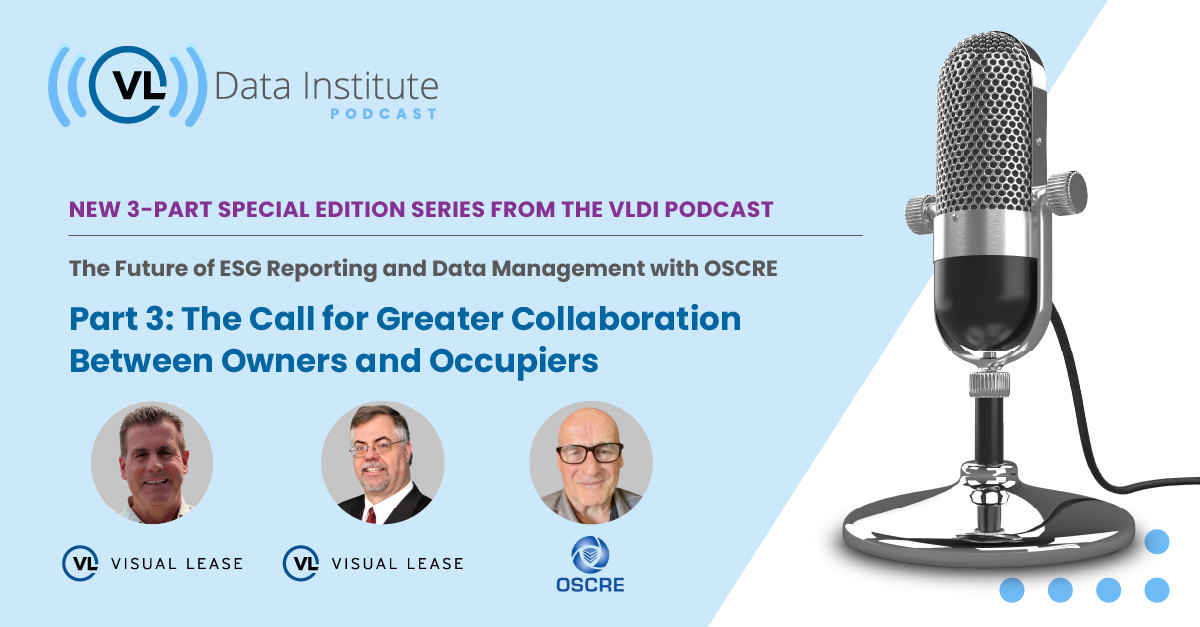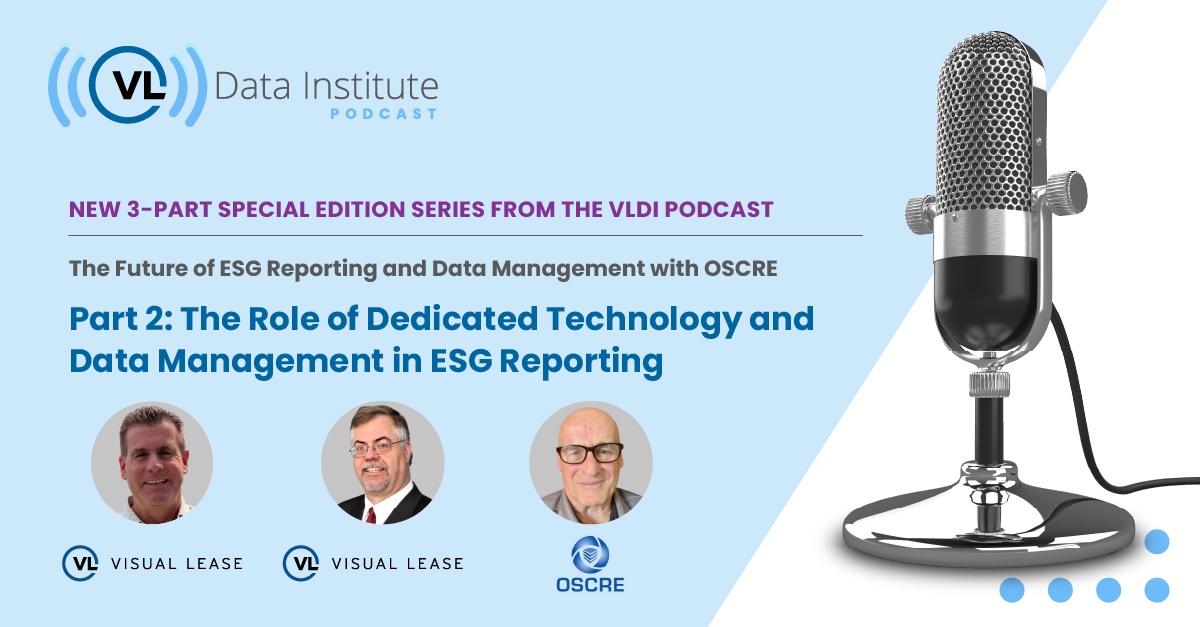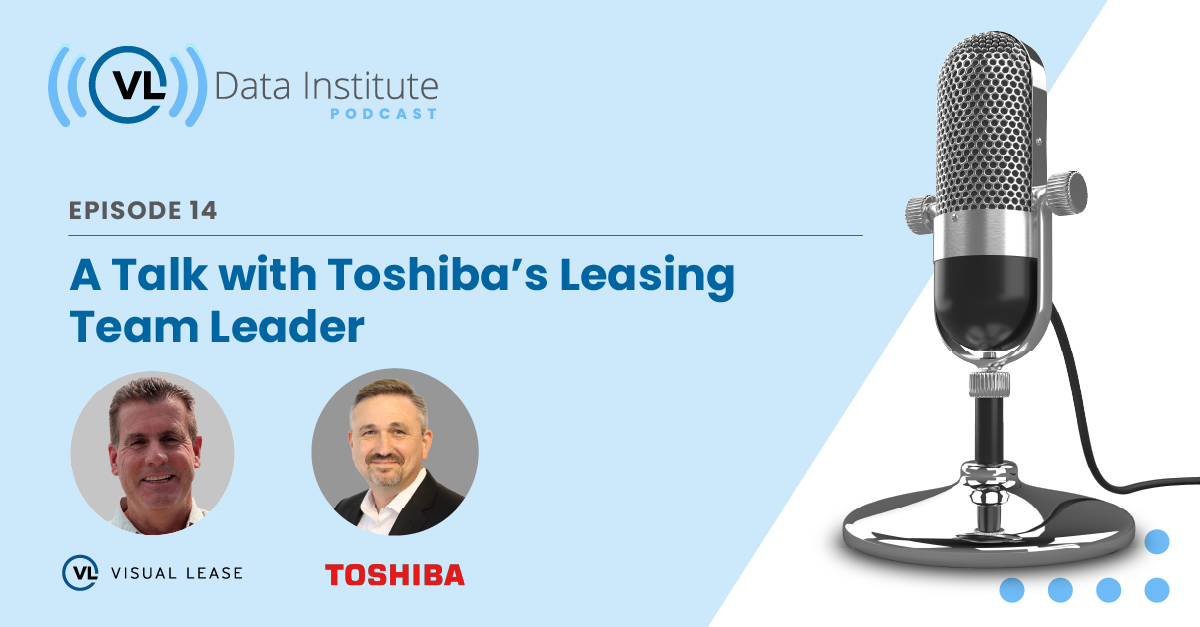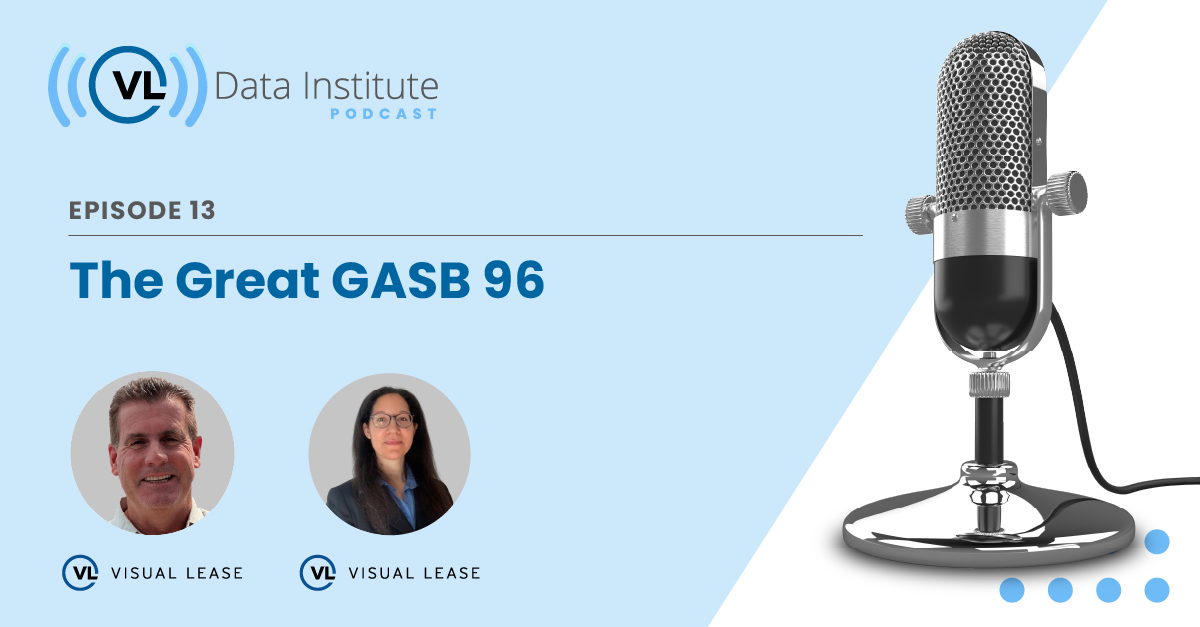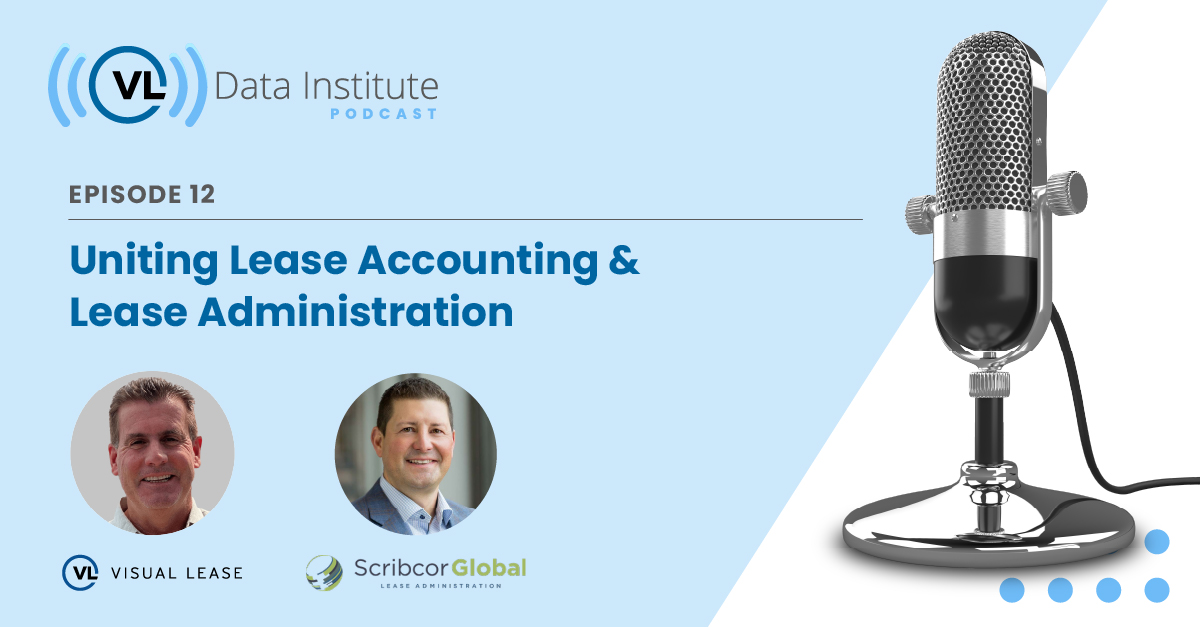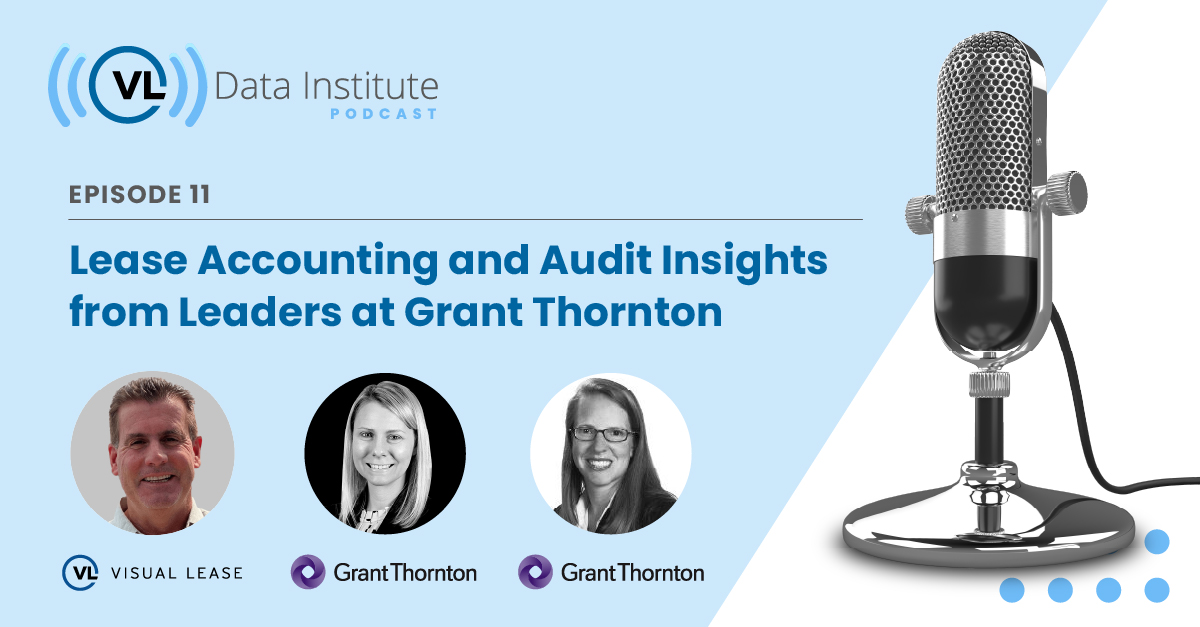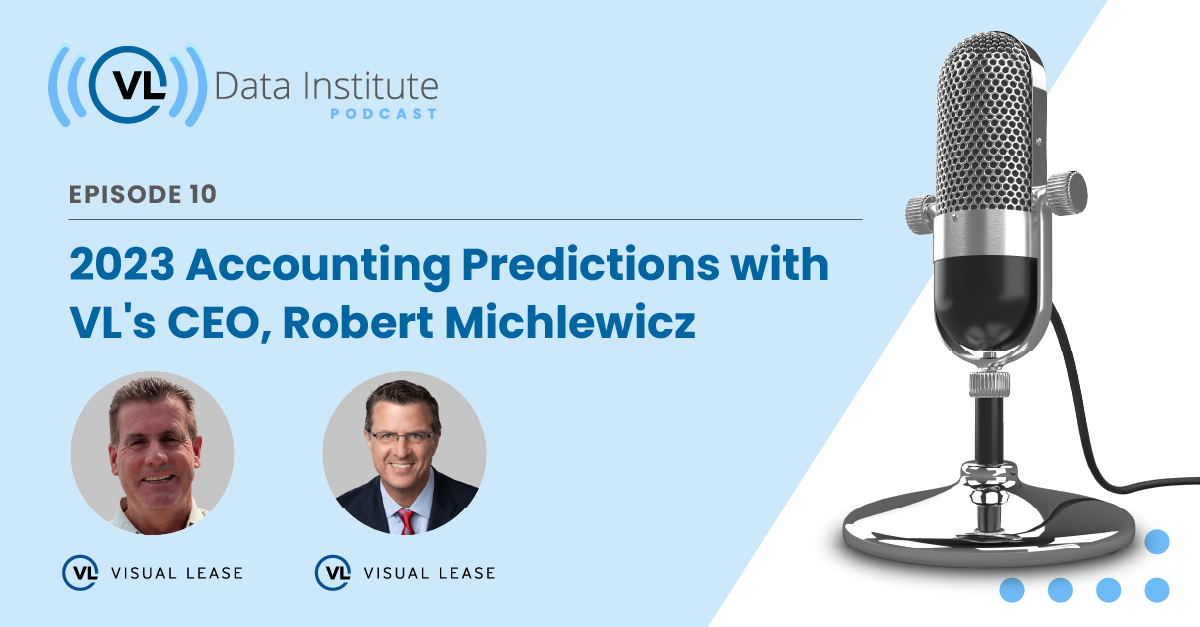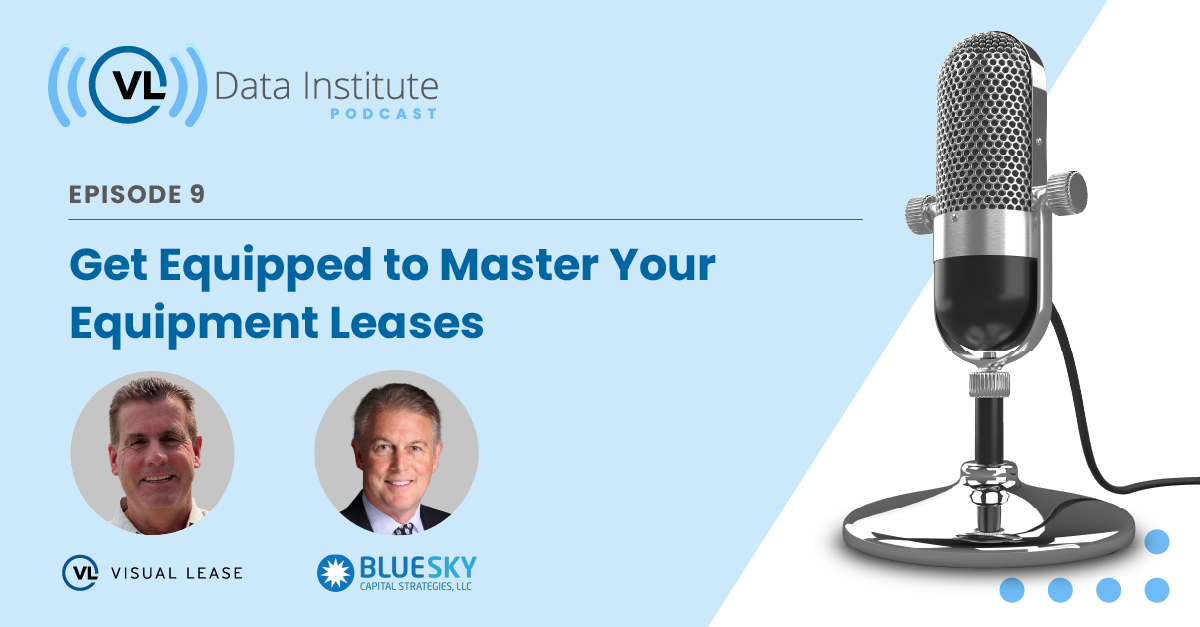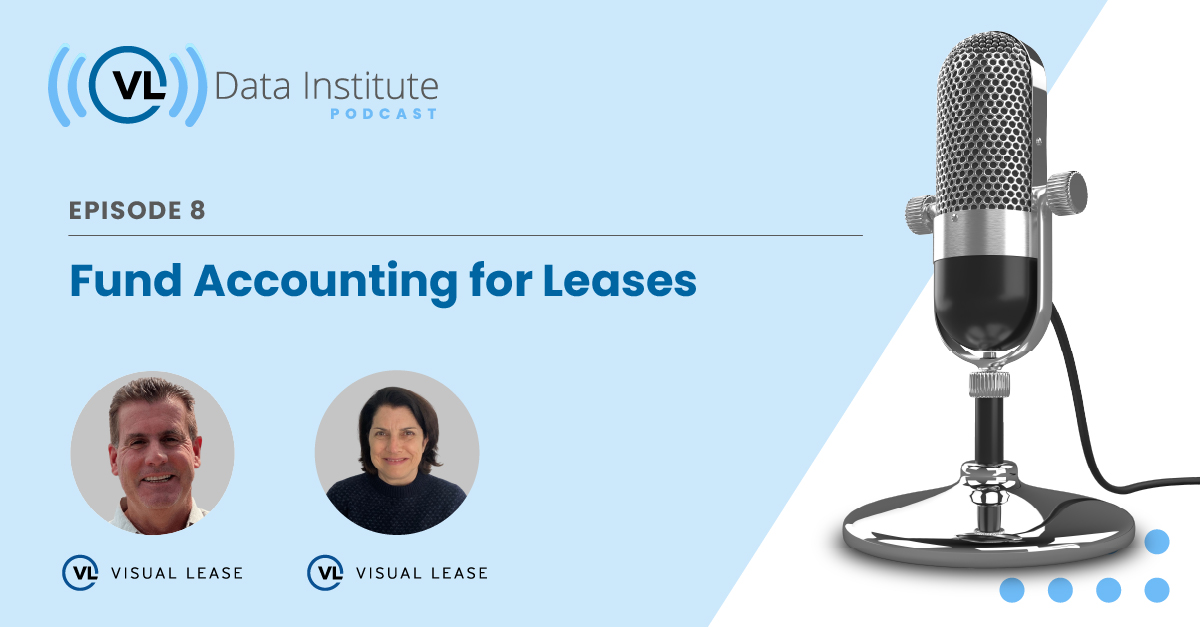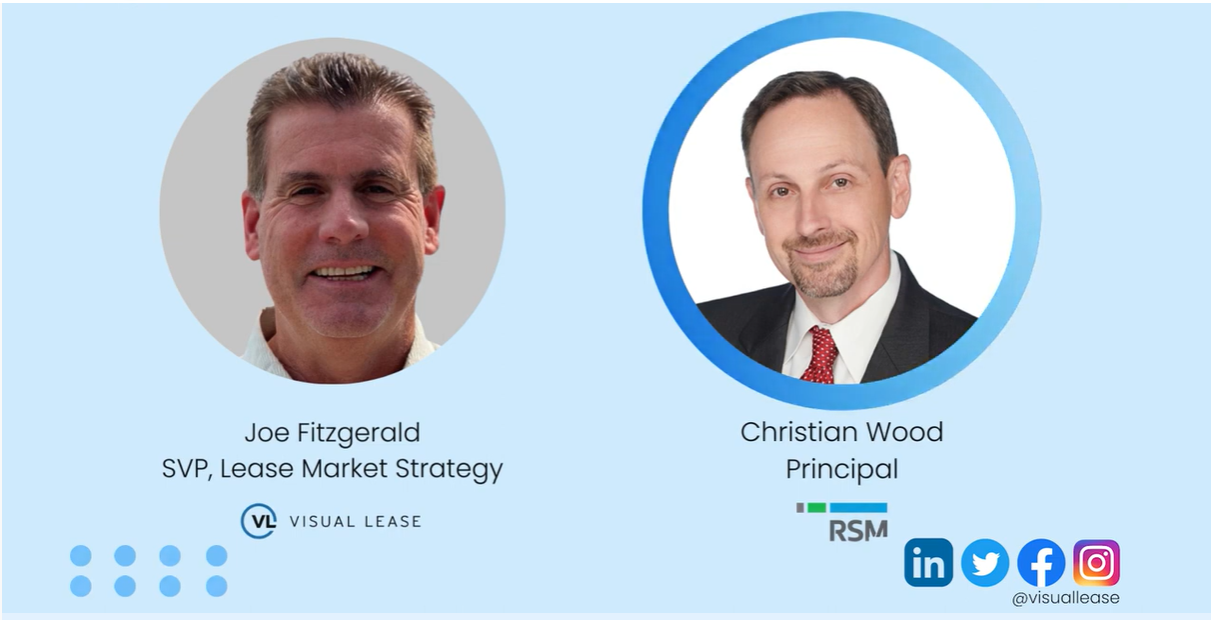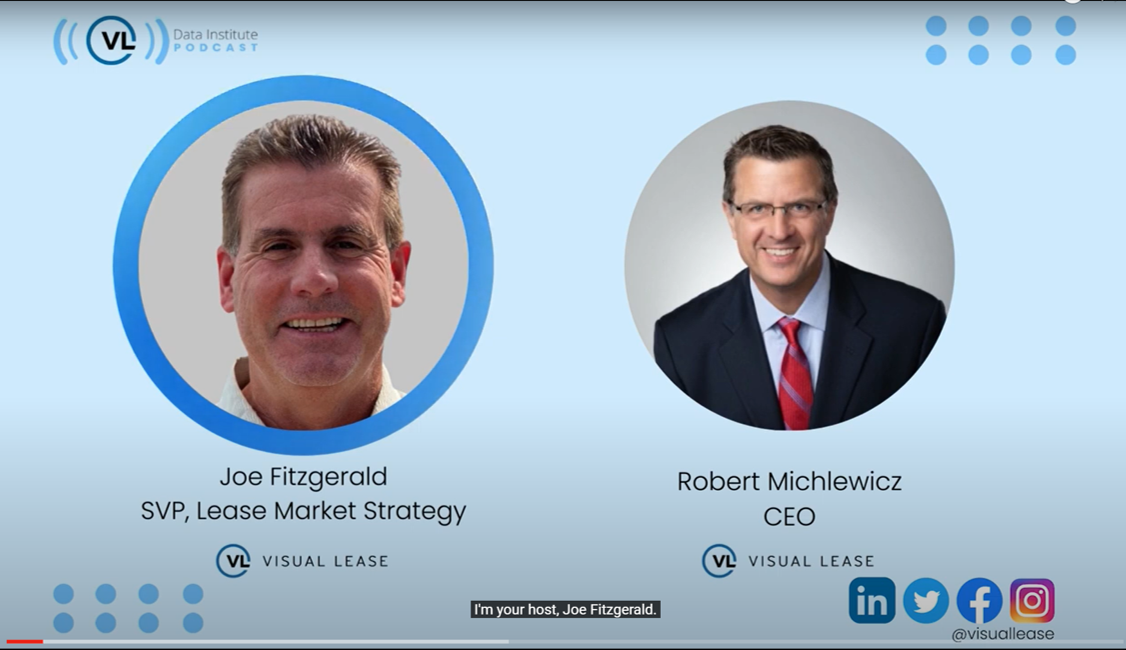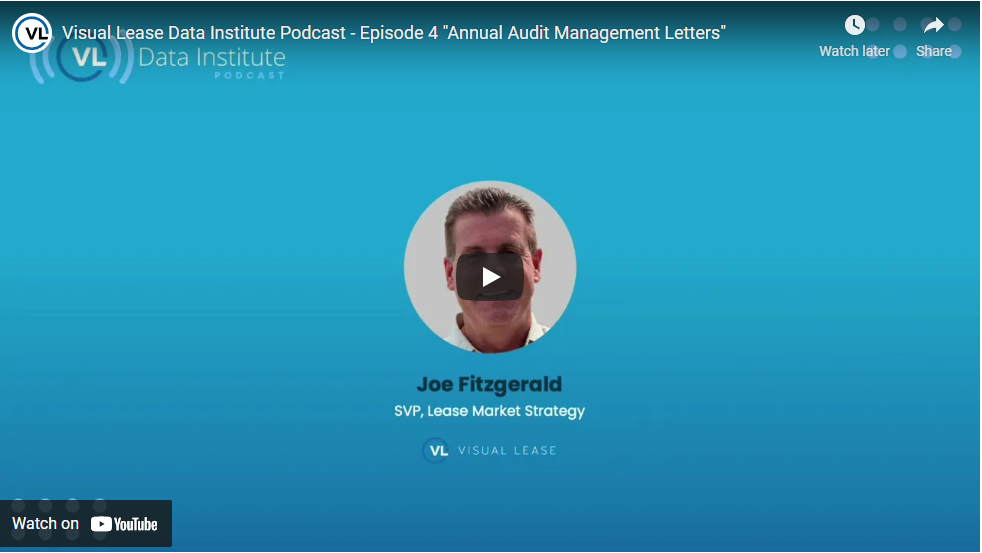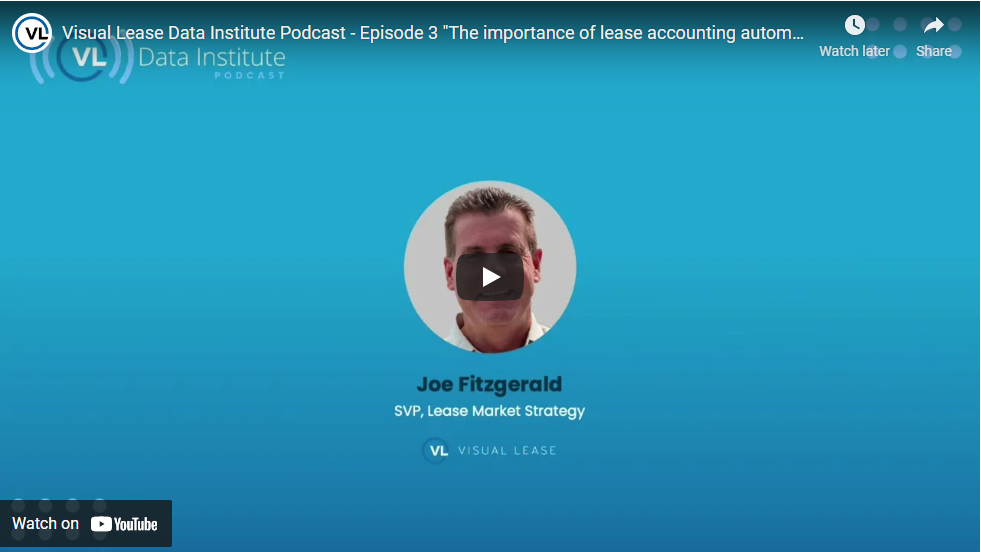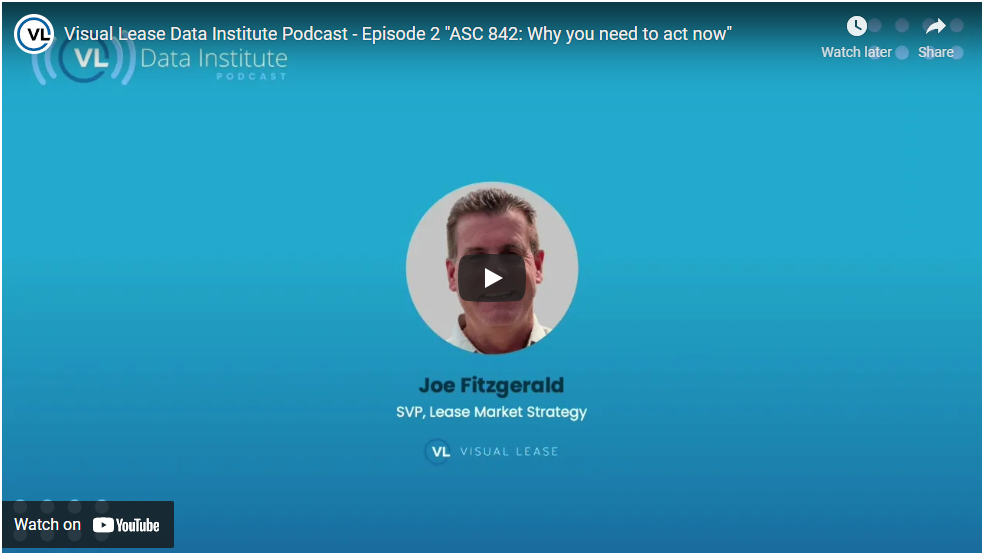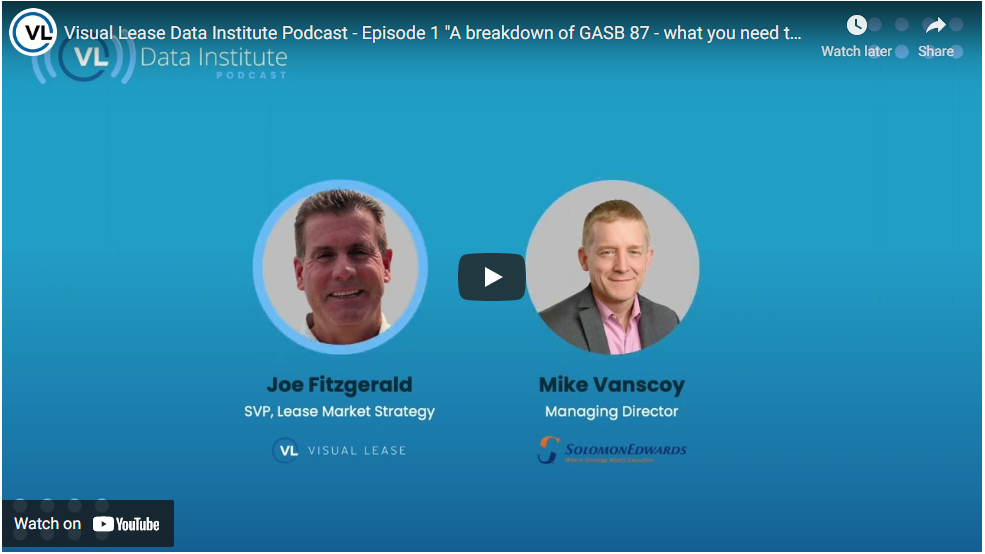Should we lease or should we buy? How has the pandemic impacted the equipment leasing market? What does my company need to know in order to confidently enter new lease agreements? All these questions answered and more in the newest episode of The VLDI Podcast!
Tune in to hear host Joe Fitzgerald sit down with Jim Cross, Co-CEO of Blue Sky Capital Strategies (a valued partner of Visual Lease), to discuss the evolution of equipment leasing.
Read Transcript
VLDI Podcast Episode 9 Transcript
Joe:
Hello and welcome to the next episode of the Visual Lease Data Institute Podcast. Here at VL, we help organizations become compliant with FASB, IFRS and GASB lease accounting standards while simultaneously improving the financial, legal and operational performance of their leases. I’m your host, Joe Fitzgerald. Today’s special guest is Jim Cross, co-CEO at Blue Sky Capital Strategies, a valued partner of Visual Lease.
Over the past 20 years, Jim has been instrumental in developing managed lease advisory programs, best practices and leasing strategies that deliver significant savings for clients ranging from Fortune 50 to Fortune 500 to several smaller public and private companies with credit profiles ranging from Double-A to early venture backed startups. Jim is trained and certified in lease versus purchase analysis, as well as various linear pricing optimization methodologies, which has enabled him to provide boardroom level after tax cash flow analysis and decision support for lease versus purchase decisions on all kinds of assets.
Jim has been responsible for advising corporate clientele as well as debt and equity investors in structured lease transactions for variety of assets. Jim’s specialties lie in lease negotiations, lease versus purchase analysis and lease syndications. In today’s episode, we’ll focus on what you need to know about equipment leases. Welcome, Jim. Thanks for joining us. We’re very happy to have you on the show today.
Jim:
Thanks, Joe. Looking forward to this.
Joe:
So, Jim, in your bio, I introduced you as being trained and certified in lease versus purchase analysis, as well as various linear pricing optimization methodologies. Now, I know that’s a mouthful. Would you mind explaining what each of these are?
Jim:
Sure. Thanks for the introduction, Joe. We really appreciate our partnership with Visual Lease and it’s great to have the opportunity to talk through a few of these leasing topics that procurement professionals, treasurers, controllers and CFOs are looking for guidance on. This is a really good question to start today’s conversation with, because an accurate lease versus purchase analysis should be the foundation for decision support on what to lease, how to structure and negotiate the contracts, as well as how to model the timing of the lease payments and the buyout options.
The most accurate form of lease versus purchase analysis really is the net present value of the after tax cash flows when it’s combined with the correct residual assumptions, using the correct discount rates for an equipment financing versus the borrowing rate for the company’s most secured over collateralized credit agreements. We review and provide feedback on lease versus purchase analysis really on a weekly basis.
Most often these models are built in Microsoft Excel and several of the input variables for the analysis are flawed. For about 25 years now, we’ve been using the most sophisticated software available for lease versus purchase analysis. We use a combination of credit markets data collected from our Bloomberg Terminal to feed software from every consulting for the lease versus purchase.
We frequently update our training. We participate in workshops for using these software tools for the lease versus purchase models that we produce for our clients, so they’re technically accurate for board level decision support and auditing. As far as the linear pricing optimization, this is really just an optional structuring and pricing approach that’s typically reserved for big ticket complex transactions.
The linear pricing optimization creates an uneven payment stream for the timing of the lease payments, as well as the timing for multiple early buyout options. This pricing optimization calculation, it delivers the absolute lowest net present value of after tax cash flows for the borrowers. The lease versus purchase models really need to be updated on a regular basis so that they can produce an accurate analysis that helps companies to realize the many benefits of leasing and to optimize the savings.
Joe:
Jim, let me ask in what ways has the pandemic followed on closely by the current economy affected equipment leasing?
Jim:
Even with the headwinds of the Labor market, the ongoing supply chain issues, inflationary pressures and big swings in monetary policy, 2022 has been a record year for equipment financing. A recent study from the Equipment Lease Financing Association shows over a 5% increase in year to date compared to 2021. Equipment financing is being used now more than ever. The market is expected to grow from 1.1 trillion in 2020 to 1.8 trillion in 2025.
The equipment financing market is then expected to grow at a record pace to reach two and a half trillion by 2030. So anytime we have a bear market and a downturn in the economy, every treasurer and CFO wants to preserve cash. So in addition to a record year of new equipment financing volumes, we’re looking at a lot of sale leaseback opportunities to bring cash back onto the balance sheet while the banks are still getting the full advantage of the bonus depreciation that starts sunsetting this year.
As the Fed has been tightening credit, there’s huge swings in how credit committees are approving and pricing these transactions. The regulated banks are the very first lenders that get alligator arms on extending credit during difficult times, especially for the middle market credits. So these specialties and independent lessors that are not regulated and they’re quick to step in and fill this gap.
There are so many companies that have been recently declined on credit approvals, so they’re quick to accept these term sheets from the specialty and the independent lessors that are filling these gaps. We’re now seeing rates, terms and conditions similar to what we saw when the financial markets imploded in 2008. So this is when you could really use an advisor to help you navigate through these cleverly written term sheets and use some real time market intelligence, as well as leverage to negotiate with these lessors for immediate and long term savings.
Another significant change that we’ve seen are the residual positions that the lessors are taking in the different equipment categories. Since the pandemic, we’re seeing record swings in residuals in several different categories, ranging from materials handling to multifunction copier devices. I can’t stress enough how important it is to understand where the residuals have been, where they are today, and where they’ll be next year.
Then most importantly is how to use that market intelligence that develops strategies to save money on your equipment lease contracts.
Joe:
So, Jim, next question. Given the numbers in terms of the growth that you just mentioned over the next several years, it sounds like you expect these trends that you’ve been talking about and we’ve been experiencing to last well into next year and beyond. Is that true?
Jim:
Yeah, it really is. You know, the number one trend that we’ve seen is preservation of cash. Without a doubt, we’re seeing more companies than ever convert from buying their CapEx assets to some form of equipment leasing. In parallel with this desire to preserve cash, there’s really an unprecedented interest in the development of best practices and strategies for managing the life cycle of the leasing contracts to deliver savings.
Another trend that we’re seeing is a focus on the lease accounting reporting. The new lease accounting standards have put a spotlight on how these leases are executed, the terms and conditions in the contracts, as well as how the contracts are managed. So we’re very fortunate to have this partnership alliance in place with Visual Lease to deliver this data for our clients.
Another trend is companies have always negotiated for savings. There seems to be a heightened sense of urgency for significant savings and these equipment lease contracts. There’s really never been a better time to be at the forefront of lease accounting and lease advisory services because the financial planning and analysis that feeds the strategy as well as the reporting that we produce for our clients typically delivers savings of about 20%.
Joe:
Jim, For the next one, I’m going to go off script a little bit here just based upon some of the stuff you’ve been saying. So where we sit in Visual Lease, when we find that we brought customers on for the lease accounting standard, it was interesting that a lot of companies really didn’t do much to manage the end of term around their non-real estate assets, their equipment leases.
And so I’m just curious, given where things are headed, do you see an increase in the need for outsourced managed services, the administration of equipment lease portfolios, particularly as it relates to the end of term?
Jim:
Yeah, for sure. The the new lease accounting standards have been extremely helpful in pushing the topic of lease administration to the top of the priority list for CFO and controllers. Over the past 25 years that we’ve provided lease advisory services. I’ve never seen so much attention and resources allocated to the oversight of the equipment lease portfolio as we’ve seen today.
I’m not suggesting that there’s been a complete void of oversight for the last 25 years. I’m just saying we’re now seeing a level of senior management involvement that we’ve never seen in the past. The new lease accounting standards have been beneficial in so many ways. One, for instance, it has forced the coordination and the consolidation of the business units, leasing activities that often went unnoticed and not properly reported.
It has also forced those responsible for lease administration to expose and improve upon the terms and conditions such as interim rents, mandatory extensions and the end of term options that have historically been used as some of the most significant yield enhancers for these leasing companies. Lease administration has really evolved simply from negotiating, managing and controlling the contract terms and conditions to the development of portfolio strategies that deliver millions of dollars in savings.
From our perspective, lease administration is finally viewed as a strategic role that has a positive influence on the company’s bottom line.
Joe:
So, Jim, let me get one final question here. Kind of your closing thoughts on how a company can best set themselves up for success and properly evaluating lease transactions as they go out into the future.
Jim:
To successfully evaluate your leasing transactions… It’s not just about the contracts. I would suggest that properly evaluating these transactions include an evaluation of things like Are your lessors capable of supporting your internal processes for purchase orders to the vendors and even understanding the lessors invoicing capabilities. You really need to focus on every detail, including the term sheet proposal in every word in the contracts.
You need to understand what goes in to your lease rate factor. You might not ever know exactly for sure how the lender priced the debt and the equity for the transaction, but there are several ways that you can get really close. And this will help for the better understanding the lessors residual position on the equipment and their overall yield expectations.
You don’t agree to move forward on any of your leasing transactions until you’ve had a chance to review all of the terms and conditions in the master lease agreement, the schedule, the equipment, return writer provisions, even the step loss tables. All of these are open for negotiation. That lease rate factor is really just the tip of the iceberg for the total cost of ownership on these contracts.
And third, make certain that you have complete clarity on the lessors verbage for how things like base rate commencement and firm term commencement are executed to really ensure that you aren’t paying any unnecessary interim rents. And if you do have fair market value contracts for your equipment, make absolutely certain that you aren’t limited to things like 12 month extension options.
Make certain that you also have any or all versus all or none extensions or return provisions. The last thing that I can think of is evaluating your equipment leasing at a portfolio level by developing baselines for your current pricing terms and conditions, and then using those baselines to measure improvements in savings on an annual basis.
Joe:
That will conclude today’s episode of The Visual Lease Data Institute Podcast. Jim, thanks so much for being here and sharing your perspective on all things equipment leases. If you enjoyed this episode and want to catch up with other resources from The Visual Lease Data Institute, be sure to follow our LinkedIn, Twitter, Instagram and Facebook pages at Visual Lease, as well as our new LinkedIn community page.
Join using the link at the YouTube description below. And don’t forget to tune in to the next episode of The Visual Lease Data Institute Podcast, where our focus is on helping you leverage your lease portfolio as a strategic asset.











